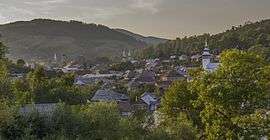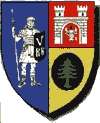Abrud
Abrud (Latin: Abruttus;[3] Hungarian: Abrudbánya; German: Großschlatten) is a town in the north-western part of Alba County, Transylvania, Romania, located on the river Abrud. It administers three villages: Abrud-Sat (Abrudfalva), Gura Cornei (Szarvaspataktorka) and Soharu (Szuhár).
Abrud | |
|---|---|
 | |
 Coat of arms | |
 Location in Alba County | |
 Abrud Location in Romania | |
| Coordinates: 46°16′26″N 23°3′48″E | |
| Country | |
| County | Alba |
| Government | |
| • Mayor | Nicolae Simina[1] (PSD) |
| Area | 32.00 km2 (12.36 sq mi) |
| Population (2011)[2] | 5,072 |
| • Density | 160/km2 (410/sq mi) |
| Time zone | EET/EEST (UTC+2/+3) |
| Vehicle reg. | AB |
| Website | http://www.primaria-abrud.ro/ |
Population
| Year | Pop. | ±% |
|---|---|---|
| 1912 | 2,938 | — |
| 1930 | 2,468 | −16.0% |
| 1948 | 2,656 | +7.6% |
| 1956 | 4,411 | +66.1% |
| 1966 | 5,150 | +16.8% |
| 1977 | 5,315 | +3.2% |
| 1992 | 6,729 | +26.6% |
| 2002 | 6,803 | +1.1% |
| 2011 | 4,944 | −27.3% |
| Source: INS, Census data | ||
According to the census from 2011 there was a total population of 4,944 people living in this commune. Of this population, 96.66% are ethnic Romanians, 0.86% are ethnic Hungarians and 0.53% ethnic Romani.[4]
History
Although first recorded only in 1271 in the form terra Obruth, the name of the town might have derived from a supposed (not attested) Dacian word for gold, *obrud.[5] The Romans erected a small fortification here in the 2nd century AD.[6] It was part of the defence system of the gold mines nearby, in "Alburnus Maior" (nowadays, Roșia Montană), but it was abandoned in the 3rd century.[6] The town's modern name reflects a characteristic vowel shift (from o to a) of the medieval Hungarian language.[5]
Abrud gained town status in 1427, during the Middle Ages. In 1727, the leaders of a revolt gained control of the town. Another serfs' revolt began in the area in 1784 with Horea, Cloșca and Crișan as leaders fighting the Austrian Imperial forces, Abrud being captured by the uprising's members on 6 November, before the revolt was crushed by the Austrian army.
People
References
| Wikimedia Commons has media related to Abrud. |
- "Elected mayors in cities, towns and communes" (in Romanian). Central Electoral Committee. Retrieved 22 August 2016.
- "Populaţia stabilă pe judeţe, municipii, oraşe şi localităti componenete la RPL_2011" (in Romanian). National Institute of Statistics. Retrieved 4 February 2014.
- Ștefan Pascu: A History of Transylvania, Dorset Press, 1990, ISBN 978-0-88029-526-0, ISBN 0-88029-526-0
- http://www.edrc.ro/recensamant.jsp?regiune_id=2568&judet_id=2569&localitate_id=2574
- Makkai, László (2001). "Transylvania's indigenous population at the time of the Hungarian conquest: Toponymy and chronology". History of Transylvania, Volume I: From the Beginnings to 1606. mek.niif.hu. Retrieved 5 January 2013.
- "1160.02". National Archaeological Record of Romania (RAN). ran.cimec.ro. 19 March 2009. Archived from the original on 19 February 2014. Retrieved 5 January 2013.
